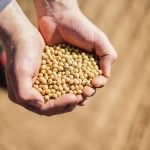A large portion of the Ontario growing region received less the 40 per cent of normal precipitation between June 10 and July 10. Temperatures were 3 C below normal across Ontario. The monthly weather forecast for Ontario calls for below normal precipitation and normal temperatures. There is potential for yield drag on corn and soybeans. However, at this stage, our contacts report that average yields are expected and the crops have held up fairly well over the past month.
Quick look
Soybeans: The market will move through a transition stage over the next two months as new crop supplies draw near.
Corn: Ontario export demand during 2022-23 should increase due to lower French output.
Wheat: About 95 per cent of Ontario winter wheat is expected to be milling quality.
Statistics Canada released its June acreage survey July 5. This report had little influence on the overall market because the data came in close to traders’ expectations. Ontario soybeans acres were 50,000 acres higher than the March survey and up 144,000 from last year. Corn acres were down 46,000 acres from the March survey and up 130,000 acres from last year. Spring wheat acres were down 41,300 acres from the March data. Winter wheat remaining was 91 per cent of the acreage planted last fall, which was not a surprise.
Read Also

Packer buys Green Giant, Le Sieur veg brands from U.S. owner
A Quebec-based processor’s deal to buy the Green Giant and Le Sieur packaged and frozen vegetable brands in Canada from a U.S. owner clarifies the status of two popular retail brands grown by Canadian farmers.
Our contacts report that Brazil’s Safrina corn harvest was 50 per cent complete as of July 10 and yields are coming in as expected. The U.S. corn crop was rated 64 per cent good to excellent as of July 10, the same reading as last year. U.S. soybeans were rated 62 per cent good to excellent as of July 10, up from 59 per cent last year.
The USDA released its acreage survey June 30. U.S. farmers planted 89.9 million acres of corn this spring, up 400,000 from the March intentions report but down 3.5 million acres from the 2021 area. U.S. soybean acres came in at 88.3 million, down 2.7 million from the March number but up 1.1 million acres from last year. Brazilian soybeans and corn offers are discount to U.S. origin for August and September. China has been cancelling old crop soybean purchases as prices have dropped sharply.
U.S. economic data suggests the U.S. economy shrank by two per cent in the second quarter of 2022. This comes on the heels of a 1.6 per cent contraction in the first quarter. We believe the U.S. economy is in a recession. Crude oil prices have dropped 15 per cent from the June highs. The U.S. dollar index is trading near 22-year highs and there has been a massive sell-off in all major currencies against the U.S. greenback. The U.S. dollar and U.S. treasuries are the safe haven investment in times of uncertainty.
Massive speculative fund liquidation has also weighed on the grain and oilseed futures markets. U.S. President Biden and Chinese President XI are expected to talk in upcoming weeks regarding U.S. tariffs on Chinese products. Traders are watching to see if these talks will have any implications for agricultural trade.
Soybeans
Ontario farmers planted 3.08 million acres of soybeans this spring, according to Statistics Canada. This was up 4.9 per cent of 144,000 acres from the 2021 planted area of 2.936 million acres. Using a traditional abandonment rate and an average yield of 50 bu./acre, production has potential to finish near 4.1 million tonnes, unchanged from the 2021 output and up from the five-year average of 3.9 million tonnes.
The Ontario soybean market is coming off a historically tight carryout. Prices for old crop supplies are rationing demand. We’re looking for the domestic crush pace to slow down late in the crop year and fresh export business has come to a standstill.
U.S. farmers planted 87.4 million acres of soybeans, according to the USDA, up 1.2 per cent or 1.1 million acres from the 2021 planted area of 86.3 million acres. Using a trend yield of 51.5 bu./acre and a typical abandonment rate, we’re now projecting the U.S. soybean crop to finish in the range of 122 to 123 million tonnes, up from the 2021 output of 120.7 million tonnes.
The soybean market will move through a transition stage over the next two months as new crop supplies draw near. U.S. soybean prices are now premium to South American origin. Recently, China has cancelled some U.S. purchases and replaced this volume with Brazilian ownership. The U.S. needs to be competitive with Brazil into China for new crop positions, which will result in lower North American prices.
World vegetable oil prices have come under pressure due to increasing palm oil output in Malaysia and Indonesia. There has also been a removal of Indonesia’s export tax. The biofuel component, which was the main driver of the vegetable oil complex, has softened due to weaker energy prices. At the time of writing this article, soyoil futures were down 25 per cent from the June high. Keep in mind domestic feed demand is at a seasonal low during September and October, setting a negative tone for meal prices.
What to do: We’ve advised Ontario farmers to be 100 per cent sold on old crop and 10 to 15 per cent sold on expected new crop production. This week, we’re advising farmers to move to a solid 20 per cent sold on expected new crop (2022) production. Ontario and U.S. soybean prices will trend lower into the harvest period due to the year-over-year increase in production. New crop prices are being held up by tight old crop supplies. There is significant downside potential for new crop prices.
Corn
Ontario farmers planted 2.276 million acres of corn this spring, according to Statistics Canada. This is up six per cent or 130,000 acres from the 2021 planted area of 2.146 million acres. Using a traditional abandonment rate and an average yield 168 bu./acre, Ontario corn production has potential to reach 9.5 million tonnes, unchanged from last year but up from the five-year average of 8.9 million tonnes. We’re projecting U.S. corn production to come in at 370 million tonnes, down from the 2021 output of 384 million tonnes but up from the five-year average of 365 million tonnes.
The Brazilian harvest will be more than 50 per cent complete by July 15. Traders are comfortable with the total corn crop forecast of 116 million tonnes, up from 87 million tonnes last year. Currently, U.S. corn offers out of the Gulf are U$35/tonne premium to Brazilian corn offers from Paranagua.
Domestic interior prices in the U.S. are being held up as the carry-out for 2021-22 is sharply below the five-year average. Ontario stocks will drop to historical lows on August 30. Argentine’s harvest is complete. Production was 53 million tonnes, up one million tonnes from last year and export values are in line with Brazil.
Ontario corn competes with French origin into Northern European destinations. French corn production is expected to come in near 13.3 million tonnes, down from 15.4 million tonnes last year. We’re looking for an increase in Ontario export demand during 2022-23 due to lower French output.
On July 8, in Blair, Nebraska and Cedar Rapids, Iowa, the corn basis for July delivery was 135 cents over the September corn futures, while October delivery was 25 cents under the December futures. A similar basis structure has developed in Ontario. Remember, Ontario farmers deliver 65 per cent of the corn crop in first five months of the crop year, which causes basis levels to deteriorate. At the time of writing this article, there was a $1 inverse between old and new crop Ontario cash prices.
What to do: We’ve advised Ontario farmers to be 100 per cent sold on old crop and 10 per cent sold on expected new crop production. This week, we’re advising farmers to sell an additional 10 per cent of their 2022 expected production, bringing total sales to 20 per cent. Corn prices tend to make a seasonal low in September. Bring sales to 20 per cent. We’ll wait until harvest is over to make our next recommendation.
Wheat
According to Statistics Canada, Ontario farmers planted 930,000 acres of winter wheat last fall, down 193,000 acres from the previous year. Winter wheat acres remaining in Ontario this spring were 848,800, down 231,000 acres from the spring of 2021. We’re forecasting the Ontario winter wheat crop to finish near two million tonnes, down from 2021 crop size of 2.7 million tonnes. We’re not hearing of major fusarium issues. We expect 95 per cent of the Ontario winter wheat crop to be milling quality.
Ontario spring wheat acres came in at 88,000 on Statistics Canada’s June acreage survey. We’re forecasting Ontario spring wheat production to come in at 112,000 tonnes, down from 142,000 tonnes last year. Total Canadian non-durum spring wheat is projected to finish near 25 million tonnes, up nine million tonnes from last year.
The Northern Hemisphere winter wheat crop harvest is in full swing. The U.S. winter wheat harvest was 63 per cent complete as of July 10. We’re forecasting U.S. hard red winter wheat output to reach 16.5 million tonnes, down from 20.5 million tonnes last year; U.S. soft red output is expected to finish near 10.3 million tonnes, up from the year-ago level of 9.8 million tonnes. U.S. hard red spring is projected to be up 4.6 million tonnes from last year at 12.7 million tonnes. The decline in U.S. hard red winter will be made up by hard red spring.
The French harvest was 22 per cent complete as of July 10. The French non-durum wheat crop is expected to come in at 33.5 million tonnes, down 2.4 million tonnes from last year. Germany’s output is forecasted to be 22.1 million tonnes, up one million tonnes from last year. The Russian wheat harvest will begin in the last half of July. Their wheat crop could be a record of 90 million tonnes, up 15 million tonnes from last year. The USDA is expecting Russian wheat exports to reach 40 million tonnes, up from the 2021-22 campaign of 33 million tonnes. That’s a big number for wheat exports.
The actual cost of wheat is a small percentage of the total bread cost. Grocery stores don’t sell food, they sell packaging. Other costs such as energy, transportation, wages, etc. are significantly higher than the cost of wheat. In 2021, the USDA reported that the farmer share of the food dollar for a loaf of bread was about four per cent. If you double the price of wheat, one would barely notice it on the grocery store shelf if all other factors remained unchanged.
What to do: We’ve advised Ontario farmers to be 100 per cent sold on old crop and 10 per cent sold on new crop. Wheat prices make a seasonal low in late July or early August. Ontario farmers sell nearly 90 per cent of their wheat in the first five months of the crop year. We’ve mentioned in the past that farmers need to have wheat storage. We’re planning to make our next sale in November.













